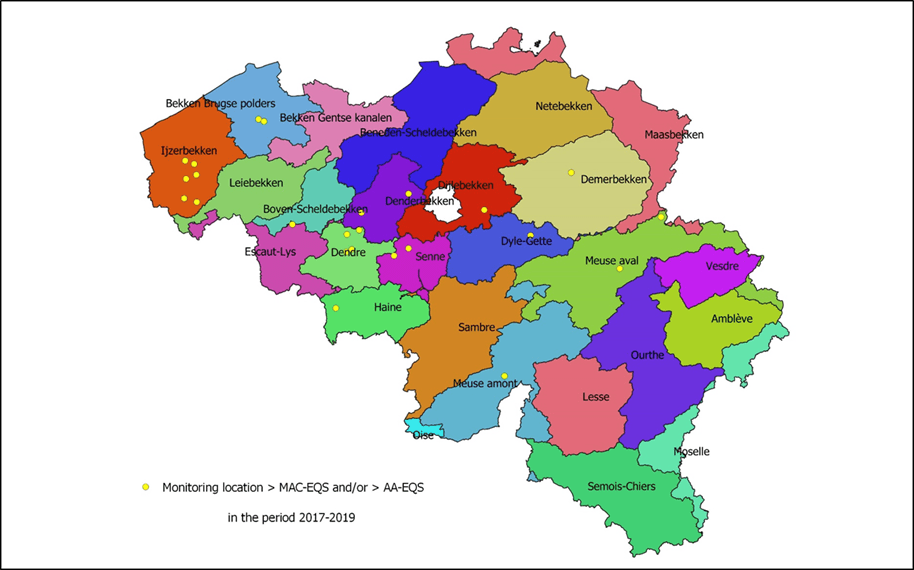Home / Reduction Plan / Charter Approach Exceedances Reference Levels Pesticides / Summary of the Emission Reduction Plan (ERP) for Terbuthylazine
Summary of the Emission Reduction Plan (ERP) for Terbuthylazine
Terbuthylazine monitoring data (provided by the Flemish and Walloon governments) for surface water during the period 2017-2019 have been tested against acute and chronic water quality standards (MAC-EQS and AA-EQS). Based on the data, the main emission routes and vulnerable regions have been identified, and a plan has been made for reducing emissions to surface water*.
Terbuthylazine is used almost exclusively (99% of use) as a post-emergence herbicide in the cultivation of maize. Negligible quantities are used in the cultivation of sorghum and giant miscanthus. It is mainly applied in May and June. Around 60% of the total quantity is used in Flanders.
The monitoring locations are distributed evenly over Flanders and Wallonia and are spread across most river basins, including in regions with the highest density of maize. There were more than 7,400 water samples in total analysed per year, originating from 247 to 284 locations. Depending on the year, no terbuthylazine was detected in 62 to 70% of the samples. Annually, 0.2 to 0.5% of the measurements were higher than the MAC-EQS. The number of locations where an environmental quality standard (EQS) was exceeded, varied from 2.1 to 4% (in absolute numbers this equals 8 to 11 locations per year, and 24 different locations over the entire three-year period).
Based on the 2017-2019 monitoring data, we have come to the following conclusions:
- The highest concentrations are observed in the months of May-June-July.
- For about 17% of the locations with measurements exceeding the environmental standards, this exceedance can be attributed to point sources (possibly due to improper use). We infer this based on the high concentrations measured at these locations.
- There were no exceedances in the Kempen and Bruges-Ghent regions (the areas with relatively the most maize).
- The most exceedances occurred along the border between Flanders and Wallonia, particularly in the West Flemish Heuvelland (Yser basin) and the province of Hainaut (Dender basin).
- In these areas, the main emission route is run-off to surface water from erosion-prone fields.
For this reason, the following specific measures are proposed for inclusion in the emission reduction plan:
- No use on fields with very high erosion risk (based on regional erosion risk classification).
- No use if there is a forecast of severe thunderstorms/extreme rainfall within 48 hours of application.
- A recommendation is being developed in Wallonia, in consultation with Protect’eau and the Walloon region
For mixtures with S-metolachlor, the following also applies:
- In Belgium, no use on soils with a sand and loamy sand texture (groundwater protection)
- In Belgium, no use in groundwater protection areas (groundwater protection)
For mixtures with dimethenamid-p, the following also applies:
- No more than 500 g terbuthylazine per hectare to be applied
As well as these additional recommendations, extra attention must be paid to the statutory measures as specified in the product authorisation certificates:
- A mandatory 20-metre vegetated buffer strip alongside surface water. This strip may not be reduced in size.
- Starting from the 2022 season: per parcel, only one use of a product containing terbuthylazine per 36 months
- Implementation of the regional anti-erosion measures as a condition for use
- Compliance with prescribed drift reducing measures
Authorisation holders of terbuthylazine are also asked to commit to the following general measures:
- Help to raise awareness on water issues through our campaigns and communication with distribution, professional applicators and growers
- Further promote wastewater collection and treatment in order to avoid point source pollution from farmyards
- Invest in development/demonstration of anti-erosion measures (such as straw wattles)
- Develop/introduce a closed transfer system for filling the spray tank
- Investigate the possibilities of band application to reduce the overall terbuthylazine volumes used per hectare
- Expand the ‘fyteauscan’ with a run-off module
- Develop a vulnerability map and digital applications for risk communication with users
*by terbuthylazine authorisation holders Syngenta Crop Protection NV, Bayer CropScience SA-NV, BASF and Sipcam OXON S.P.A.
